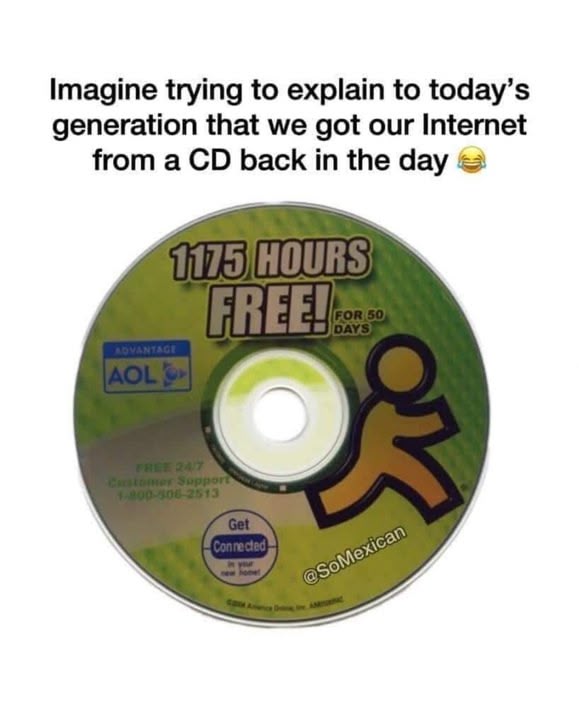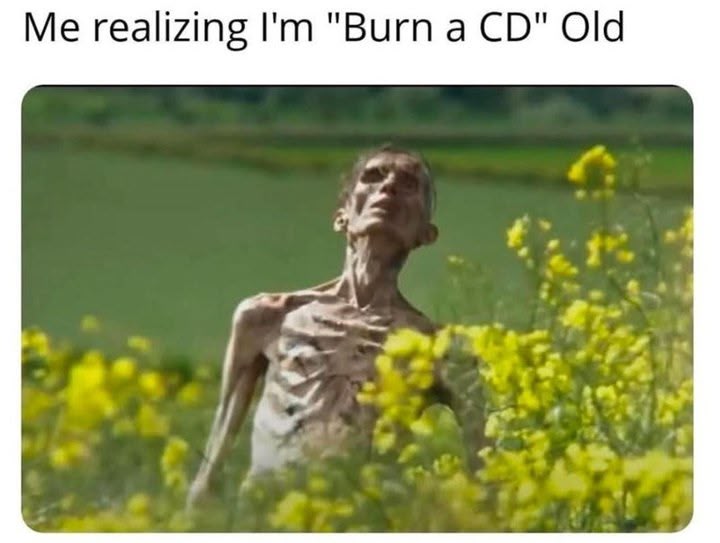My stepfather told me when they changed to unlimited good luck getting a connection
@AllycatAD more like good luck getting a connection when mom and dad were expecting an important incoming phone call at home 💀🤣
SinlessOnslaught · M
Omg I just barely remember that! You reminded me. I was like 4.
@SinlessOnslaught bet you tossed them like frisbees too then 😉
tobynshorty · 51-55, F
I have never seen anything like this
SomeMichGuy · M
@tobynshorty used to claim the free hrs from the trial format my pc and add another trial. Before social media we had chatrooms on AOL and yahoo…yessir good times from when dinosaurs roamed the earth 👴
Longpatrol · 31-35, M
Strange I had internet access form 1998 or 1999 onwards, never saw this
SomeMichGuy · M
@Longpatrol I used to see them everywhere bro at some point they were even on the cereal box as a prize to entice people to venture onto the www. lol
SomeMichGuy · M
@userfawkes1105 EXACTLY.
They were very persistent to get new customers; the Mormons of dial-in ISPs...
They were very persistent to get new customers; the Mormons of dial-in ISPs...
SomeMichGuy · M
True. They burned and mailed so many of those that some people used them as coasters...
Levenrack · 46-50, M
What a strange-looking artifact. I think it might have been built with nefarious events in mind.
@Levenrack 💯 But we were too naive back then to even fathom the risks.
calicuz · 56-60, M
Ha, you boomers make me laugh. 😂
View 3 more replies »
calicuz · 56-60, M
@userfawkes1105
I can honestly say that I have never seen the cartridge. Maybe they thought the future was access through gaming consoles.
I can honestly say that I have never seen the cartridge. Maybe they thought the future was access through gaming consoles.
calicuz · 56-60, M
SomeMichGuy · M
@calicuz Well, they were part of the dial-up era, so it WAS a phone-based service.
For years, the "last mile" of home internet access was a dial-up phone link using modems.
The first version of the US's internet backbone used T0-speed phone lines (56 kbps, a single-channel digital phone circuit), which was upgraded under the NSFNet project to T1 (1.544 Mbps, or just over 27.57x T0), then THAT backbone was upgraded to T3 (44.736 Mbps, or just under 29x T1).
Let's see...these wikipedia articles
[ihttps://en.m.wikipedia.org/wiki/Digital_Signal_1
]https://en.m.wikipedia.org/wiki/Digital_Signal_3[/i]
use different multiples, likely due to overhead when you actually multiplex the data; as the first articke notes:
[This is always the case; people used to post actual throughput measured on "10-Mbit" ethernet cable, and the overhead of the protocol, etc., reduces that a bit.]
For years, the "last mile" of home internet access was a dial-up phone link using modems.
The first version of the US's internet backbone used T0-speed phone lines (56 kbps, a single-channel digital phone circuit), which was upgraded under the NSFNet project to T1 (1.544 Mbps, or just over 27.57x T0), then THAT backbone was upgraded to T3 (44.736 Mbps, or just under 29x T1).
Let's see...these wikipedia articles
[ihttps://en.m.wikipedia.org/wiki/Digital_Signal_1
]https://en.m.wikipedia.org/wiki/Digital_Signal_3[/i]
use different multiples, likely due to overhead when you actually multiplex the data; as the first articke notes:
The line speed is always 1.544 Mbit/s, but the payload can vary greatly.[9]
[This is always the case; people used to post actual throughput measured on "10-Mbit" ethernet cable, and the overhead of the protocol, etc., reduces that a bit.]
TheOneyouwerewarnedabout · 46-50, MVIP















